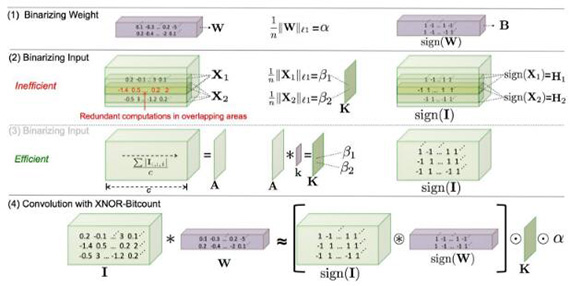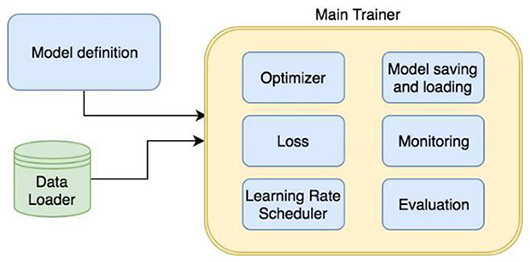当我第一次尝试学习 PyTorch 时,没几天就放弃了。和 TensorFlow 相比,我很难弄清 PyTorch 的核心要领。但是随后不久,PyTorch 发布了一个新版本,我决定重新来过。在第二次的学习中,我开始了解这个框架的易用性。在本文中,我会简要解释 PyTorch 的核心概念,为你转入这个框架提供一些必要的动力。其中包含了一些基础概念,以及先进的功能如学习速率调整、自定义层等等。
PyTorch 的易用性如何?Andrej Karpathy 是这样评价的
资源
- 首先要知道的是:PyTorch 的主目录和教程是分开的。而且因为开发和版本更新的速度过快,有时候两者之间并不匹配。所以你需要不时查看源代码:http://pytorch.org/tutorials/。
- 当然,目前网络上已有了一些 PyTorch 论坛,你可以在其中询问相关的问题,并很快得到回复:https://discuss.pytorch.org/。
把 PyTorch 当做 NumPy 用
让我们先看看 PyTorch 本身,其主要构件是张量——这和 NumPy 看起来差不多。这种性质使得 PyTorch 可支持大量相同的 API,所以有时候你可以把它用作是 NumPy 的替代品。PyTorch 的开发者们这么做的原因是希望这种框架可以完全获得 GPU 加速带来的便利,以便你可以快速进行数据预处理,或其他任何机器学习任务。将张量从 NumPy 转换至 PyTorch 非常容易,反之亦然。让我们看看如下代码:
- importtorch
- importnumpy asnp
- numpy_tensor =np.random.randn(10,20)
- # convert numpy array to pytorch array
- pytorch_tensor =torch.Tensor(numpy_tensor)
- # or another way
- pytorch_tensor =torch.from_numpy(numpy_tensor)
- # convert torch tensor to numpy representation
- pytorch_tensor.numpy()
- # if we want to use tensor on GPU provide another type
- dtype =torch.cuda.FloatTensor
- gpu_tensor =torch.randn(10,20).type(dtype)
- # or just call `cuda()` method
- gpu_tensor =pytorch_tensor.cuda()
- # call back to the CPU
- cpu_tensor =gpu_tensor.cpu()
- # define pytorch tensors
- x =torch.randn(10,20)
- y =torch.ones(20,5)
- # `@` mean matrix multiplication from python3.5, PEP-0465
- res =x @y
- # get the shape
- res.shape # torch.Size([10, 5])
从张量到变量
张量是 PyTorch 的一个完美组件,但是要想构建神经网络这还远远不够。反向传播怎么办?当然,我们可以手动实现它,但是真的需要这样做吗?幸好还有自动微分。为了支持这个功能,PyTorch 提供了变量,它是张量之上的封装。如此,我们可以构建自己的计算图,并自动计算梯度。每个变量实例都有两个属性:包含初始张量本身的.data,以及包含相应张量梯度的.grad
- importtorch
- fromtorch.autograd importVariable
- # define an inputs
- x_tensor =torch.randn(10,20)
- y_tensor =torch.randn(10,5)
- x =Variable(x_tensor,requires_grad=False)
- y =Variable(y_tensor,requires_grad=False)
- # define some weights
- w =Variable(torch.randn(20,5),requires_grad=True)
- # get variable tensor
- print(type(w.data))# torch.FloatTensor
- # get variable gradient
- print(w.grad)# None
- loss =torch.mean((y -x @w)**2)
- # calculate the gradients
- loss.backward()
- print(w.grad)# some gradients
- # manually apply gradients
- w.data -=0.01*w.grad.data
- # manually zero gradients after update
- w.grad.data.zero_()
你也许注意到我们手动计算了自己的梯度,这样看起来很麻烦,我们能使用优化器吗?当然。
- importtorch
- fromtorch.autograd importVariable
- importtorch.nn.functional asF
- x =Variable(torch.randn(10,20),requires_grad=False)
- y =Variable(torch.randn(10,3),requires_grad=False)
- # define some weights
- w1 =Variable(torch.randn(20,5),requires_grad=True)
- w2 =Variable(torch.randn(5,3),requires_grad=True)
- learning_rate =0.1
- loss_fn =torch.nn.MSELoss()
- optimizer =torch.optim.SGD([w1,w2],lr=learning_rate)
- forstep inrange(5):
- pred =F.sigmoid(x @w1)
- pred =F.sigmoid(pred @w2)
- loss =loss_fn(pred,y)
- # manually zero all previous gradients
- optimizer.zero_grad()
- # calculate new gradients
- loss.backward()
- # apply new gradients
- optimizer.step()
并不是所有的变量都可以自动更新。但是你应该可以从最后一段代码中看到重点:我们仍然需要在计算新梯度之前将它手动归零。这是 PyTorch 的核心理念之一。有时我们会不太明白为什么要这么做,但另一方面,这样可以让我们充分控制自己的梯度。
静态图 vs 动态图
PyTorch 和 TensorFlow 的另一个主要区别在于其不同的计算图表现形式。TensorFlow 使用静态图,这意味着我们是先定义,然后不断使用它。在 PyTorch 中,每次正向传播都会定义一个新计算图。在开始阶段,两者之间或许差别不是很大,但动态图会在你希望调试代码,或定义一些条件语句时显现出自己的优势。就像你可以使用自己最喜欢的 debugger 一样!
你可以比较一下 while 循环语句的下两种定义——第一个是 TensorFlow 中,第二个是 PyTorch 中:
- importtensorflow astf
- first_counter =tf.constant(0)
- second_counter =tf.constant(10)
- some_value =tf.Variable(15)
- # condition should handle all args:
- defcond(first_counter,second_counter,*args):
- returnfirst_counter <second_counter
- defbody(first_counter,second_counter,some_value):
- first_counter =tf.add(first_counter,2)
- second_counter =tf.add(second_counter,1)
- returnfirst_counter,second_counter,some_value
- c1,c2,val =tf.while_loop(
- cond,body,[first_counter,second_counter,some_value])
- withtf.Session()assess:
- sess.run(tf.global_variables_initializer())
- counter_1_res,counter_2_res =sess.run([c1,c2])
- importtorch
- first_counter =torch.Tensor([0])
- second_counter =torch.Tensor([10])
- some_value =torch.Tensor(15)
- while(first_counter <second_counter)[0]:
- first_counter +=2
- second_counter +=1
看起来第二种方法比第一个简单多了,你觉得呢?
模型定义
现在我们看到,想在 PyTorch 中创建 if/else/while 复杂语句非常容易。不过让我们先回到常见模型中,PyTorch 提供了非常类似于 Keras 的、即开即用的层构造函数:
神经网络包(nn)定义了一系列的模块,它可以粗略地等价于神经网络的层。模块接收输入变量并计算输出变量,但也可以保存内部状态,例如包含可学习参数的变量。nn 包还定义了一组在训练神经网络时常用的损失函数。
- fromcollections importOrderedDict
- importtorch.nn asnn
- # Example of using Sequential
- model =nn.Sequential(
- nn.Conv2d(1,20,5),
- nn.ReLU(),
- nn.Conv2d(20,64,5),
- nn.ReLU()
- )
- # Example of using Sequential with OrderedDict
- model =nn.Sequential(OrderedDict([
- ('conv1',nn.Conv2d(1,20,5)),
- ('relu1',nn.ReLU()),
- ('conv2',nn.Conv2d(20,64,5)),
- ('relu2',nn.ReLU())
- ]))
- output =model(some_input)
如果你想要构建复杂的模型,我们可以将 nn.Module 类子类化。当然,这两种方式也可以互相结合。
- fromtorch importnn
- classModel(nn.Module):
- def__init__(self):
- super().__init__()
- self.feature_extractor =nn.Sequential(
- nn.Conv2d(3,12,kernel_size=3,padding=1,stride=1),
- nn.Conv2d(12,24,kernel_size=3,padding=1,stride=1),
- )
- self.second_extractor =nn.Conv2d(
- 24,36,kernel_size=3,padding=1,stride=1)
- defforward(self,x):
- x =self.feature_extractor(x)
- x =self.second_extractor(x)
- # note that we may call same layer twice or mode
- x =self.second_extractor(x)
- returnx
在__init__方法中,我们需要定义之后需要使用的所有层。在正向方法中,我们需要提出如何使用已经定义的层的步骤。而在反向传播上,和往常一样,计算是自动进行的。
自定义层
如果我们想要定义一些非标准反向传播模型要怎么办?这里有一个例子——XNOR 网络:
在这里我们不会深入细节,如果你对它感兴趣,可以参考一下原始论文:
https://arxiv.org/abs/1603.05279
与我们问题相关的是反向传播需要权重必须介于-1 到 1 之间。在 PyTorch 中,这可以很容易实现:
- importtorch
- classMyFunction(torch.autograd.Function):
- @staticmethod
- defforward(ctx,input):
- ctx.save_for_backward(input)
- output =torch.sign(input)
- returnoutput
- @staticmethod
- defbackward(ctx,grad_output):
- # saved tensors - tuple of tensors, so we need get first
- input,=ctx.saved_variables
- grad_output[input.ge(1)]=0
- grad_output[input.le(-1)]=0
- returngrad_output
- # usage
- x =torch.randn(10,20)
- y =MyFunction.apply(x)
- # or
- my_func =MyFunction.apply
- y =my_func(x)
- # and if we want to use inside nn.Module
- classMyFunctionModule(torch.nn.Module):
- defforward(self,x):
- returnMyFunction.apply(x)
正如你所见,我们应该只定义两种方法:一个为正向传播,一个为反向传播。如果我们需要从正向通道访问一些变量,我们可以将它们存储在 ctx 变量中。注意:在此前的 API 正向/反向传播不是静态的,我们存储变量需要以 self.save_for_backward(input) 的形式,并以 input, _ = self.saved_tensors 的方式接入。
在 CUDA 上训练模型
我们曾经讨论过传递一个张量到 CUDA 上。但如果希望传递整个模型,我们可以通过调用.cuda() 来完成,并将每个输入变量传递到.cuda() 中。在所有计算后,我们需要用返回.cpu() 的方法来获得结果。
同时,PyTorch 也支持在源代码中直接分配设备:
- importtorch
- ### tensor example
- x_cpu =torch.randn(10,20)
- w_cpu =torch.randn(20,10)
- # direct transfer to the GPU
- x_gpu =x_cpu.cuda()
- w_gpu =w_cpu.cuda()
- result_gpu =x_gpu @w_gpu
- # get back from GPU to CPU
- result_cpu =result_gpu.cpu()
- ### model example
- modelmodel =model.cuda()
- # train step
- inputs =Variable(inputs.cuda())
- outputs =model(inputs)
- # get back from GPU to CPU
- outputsoutputs =outputs.cpu()
因为有些时候我们想在 CPU 和 GPU 中运行相同的模型,而无需改动代码,我们会需要一种封装:
- classTrainer:
- def__init__(self,model,use_cuda=False,gpu_idx=0):
- self.use_cuda =use_cuda
- self.gpu_idx =gpu_idx
- selfself.model =self.to_gpu(model)
- defto_gpu(self,tensor):
- ifself.use_cuda:
- returntensor.cuda(self.gpu_idx)
- else:
- returntensor
- deffrom_gpu(self,tensor):
- ifself.use_cuda:
- returntensor.cpu()
- else:
- returntensor
- deftrain(self,inputs):
- inputs =self.to_gpu(inputs)
- outputs =self.model(inputs)
- outputs =self.from_gpu(outputs)
权重初始化
在 TesnorFlow 中权重初始化主要是在张量声明中进行的。PyTorch 则提供了另一种方法:首先声明张量,随后在下一步里改变张量的权重。权重可以用调用 torch.nn.init 包中的多种方法初始化为直接访问张量的属性。这个决定或许并不直接了当,但当你希望初始化具有某些相同初始化类型的层时,它就会变得有用。
- importtorch
- fromtorch.autograd importVariable
- # new way with `init` module
- w =torch.Tensor(3,5)
- torch.nn.init.normal(w)
- # work for Variables also
- w2 =Variable(w)
- torch.nn.init.normal(w2)
- # old styled direct access to tensors data attribute
- w2.data.normal_()
- # example for some module
- defweights_init(m):
- classname =m.__class__.__name__
- ifclassname.find('Conv')!=-1:
- m.weight.data.normal_(0.0,0.02)
- elifclassname.find('BatchNorm')!=-1:
- m.weight.data.normal_(1.0,0.02)
- m.bias.data.fill_(0)
- # for loop approach with direct access
- classMyModel(nn.Module):
- def__init__(self):
- form inself.modules():
- ifisinstance(m,nn.Conv2d):
- n =m.kernel_size[0]*m.kernel_size[1]*m.out_channels
- m.weight.data.normal_(0,math.sqrt(2./n))
- elifisinstance(m,nn.BatchNorm2d):
- m.weight.data.fill_(1)
- m.bias.data.zero_()
- elifisinstance(m,nn.Linear):
- m.bias.data.zero_()
反向排除子图
有时,当你希望保留模型中的某些层或者为生产环境做准备的时候,禁用某些层的自动梯度机制非常有用。在这种思路下,PyTorch 设计了两个 flag:requires_grad 和 volatile。第一个可以禁用当前层的梯度,但子节点仍然可以计算。第二个可以禁用自动梯度,同时效果沿用至所有子节点。
- importtorch
- fromtorch.autograd importVariable
- # requires grad
- # If there’s a single input to an operation that requires gradient,
- # its output will also require gradient.
- x =Variable(torch.randn(5,5))
- y =Variable(torch.randn(5,5))
- z =Variable(torch.randn(5,5),requires_grad=True)
- a =x +y
- a.requires_grad # False
- b =a +z
- b.requires_grad # True
- # Volatile differs from requires_grad in how the flag propagates.
- # If there’s even a single volatile input to an operation,
- # its output is also going to be volatile.
- x =Variable(torch.randn(5,5),requires_grad=True)
- y =Variable(torch.randn(5,5),volatile=True)
- a =x +y
- a.requires_grad # False
训练过程
当然,PyTorch 还有一些其他卖点。例如你可以设定学习速率,让它以特定规则进行变化。或者你可以通过简单的训练标记允许/禁止批规范层和 dropout。如果你想要做的话,让 CPU 和 GPU 的随机算子不同也是可以的。
- # scheduler example
- fromtorch.optim importlr_scheduler
- optimizer =torch.optim.SGD(model.parameters(),lr=0.01)
- scheduler =lr_scheduler.StepLR(optimizer,step_size=30,gamma=0.1)
- forepoch inrange(100):
- scheduler.step()
- train()
- validate()
- # Train flag can be updated with boolean
- # to disable dropout and batch norm learning
- model.train(True)
- # execute train step
- model.train(False)
- # run inference step
- # CPU seed
- torch.manual_seed(42)
- # GPU seed
- torch.cuda.manual_seed_all(42)
同时,你也可以添加模型信息,或存储/加载一小段代码。如果你的模型是由 OrderedDict 或基于类的模型字符串,它的表示会包含层名。
- fromcollections importOrderedDict
- importtorch.nn asnn
- model =nn.Sequential(OrderedDict([
- ('conv1',nn.Conv2d(1,20,5)),
- ('relu1',nn.ReLU()),
- ('conv2',nn.Conv2d(20,64,5)),
- ('relu2',nn.ReLU())
- ]))
- print(model)
- # Sequential (
- # (conv1): Conv2d(1, 20, kernel_size=(5, 5), stride=(1, 1))
- # (relu1): ReLU ()
- # (conv2): Conv2d(20, 64, kernel_size=(5, 5), stride=(1, 1))
- # (relu2): ReLU ()
- # )
- # save/load only the model parameters(prefered solution)
- torch.save(model.state_dict(),save_path)
- model.load_state_dict(torch.load(save_path))
- # save whole model
- torch.save(model,save_path)
- model =torch.load(save_path)
根据 PyTorch 文档,用 state_dict() 的方式存储文档更好。
记录
训练过程的记录是一个非常重要的部分。不幸的是,PyTorch 目前还没有像 Tensorboard 这样的东西。所以你只能使用普通文本记录 Python 了,你也可以试试一些第三方库:
- logger:https://github.com/oval-group/logger
- Crayon:https://github.com/torrvision/crayon
- tensorboard_logger:https://github.com/TeamHG-Memex/tensorboard_logger
- tensorboard-pytorch:https://github.com/lanpa/tensorboard-pytorch
- Visdom:https://github.com/facebookresearch/visdom
掌控数据
你可能会记得 TensorFlow 中的数据加载器,甚至想要实现它的一些功能。对于我来说,我花了四个小时来掌握其中所有管道的执行原理。
首先,我想在这里添加一些代码,但我认为上图足以解释它的基础理念了。
PyTorch 开发者不希望重新发明轮子,他们只是想要借鉴多重处理。为了构建自己的数据加载器,你可以从 torch.utils.data.Dataset 继承类,并更改一些方法:
- importtorch
- importtorchvision astv
- classImagesDataset(torch.utils.data.Dataset):
- def__init__(self,df,transform=None,
- loader=tv.datasets.folder.default_loader):
- self.df =df
- self.transform =transform
- self.loader =loader
- def__getitem__(self,index):
- row =self.df.iloc[index]
- target =row['class_']
- path =row['path']
- img =self.loader(path)
- ifself.transform isnotNone:
- img =self.transform(img)
- returnimg,target
- def__len__(self):
- n,_ =self.df.shape
- returnn
- # what transformations should be done with our images
- data_transforms =tv.transforms.Compose([
- tv.transforms.RandomCrop((64,64),padding=4),
- tv.transforms.RandomHorizontalFlip(),
- tv.transforms.ToTensor(),
- ])
- train_df =pd.read_csv('path/to/some.csv')
- # initialize our dataset at first
- train_dataset =ImagesDataset(
- df=train_df,
- transform=data_transforms
- )
- # initialize data loader with required number of workers and other params
- train_loader =torch.utils.data.DataLoader(train_dataset,
- batch_size=10,
- shuffle=True,
- num_workers=16)
- # fetch the batch(call to `__getitem__` method)
- forimg,target intrain_loader:
- pass
有两件事你需要事先知道:
1. PyTorch 的图维度和 TensorFlow 的不同。前者的是 [Batch_size × channels × height × width] 的形式。但如果你没有通过预处理步骤 torchvision.transforms.ToTensor() 进行交互,则可以进行转换。在 transforms 包中还有很多有用小工具。
2. 你很可能会使用固定内存的 GPU,对此,你只需要对 cuda() 调用额外的标志 async = True,并从标记为 pin_memory = True 的 DataLoader 中获取固定批次。
最终架构
现在我们了解了模型、优化器和很多其他细节。是时候来个总结了:
这里有一段用于解读的伪代码:
- classImagesDataset(torch.utils.data.Dataset):
- pass
- classNet(nn.Module):
- pass
- model =Net()
- optimizer =torch.optim.SGD(model.parameters(),lr=0.01)
- scheduler =lr_scheduler.StepLR(optimizer,step_size=30,gamma=0.1)
- criterion =torch.nn.MSELoss()
- dataset =ImagesDataset(path_to_images)
- data_loader =torch.utils.data.DataLoader(dataset,batch_size=10)
- train =True
- forepoch inrange(epochs):
- iftrain:
- lr_scheduler.step()
- forinputs,labels indata_loader:
- inputs =Variable(to_gpu(inputs))
- labels =Variable(to_gpu(labels))
- outputs =model(inputs)
- loss =criterion(outputs,labels)
- iftrain:
- optimizer.zero_grad()
- loss.backward()
- optimizer.step()
- ifnottrain:
- save_best_model(epoch_validation_accuracy)
结论
希望本文可以让你了解 PyTorch 的如下特点:
- 它可以用来代替 Numpy
- 它的原型设计非常快
- 调试和使用条件流非常简单
- 有很多方便且开箱即用的工具
PyTorch 是一个正在快速发展的框架,背靠一个富有活力的社区。现在是尝试 PyTorch 的好时机。
【本文是51CTO专栏机构“机器之心”的原创译文,微信公众号“机器之心( id: almosthuman2014)”】





































